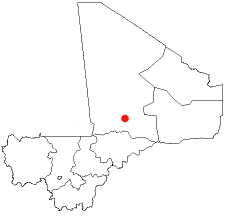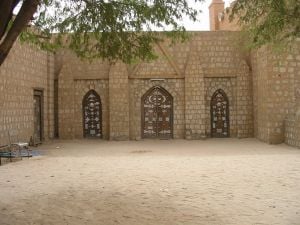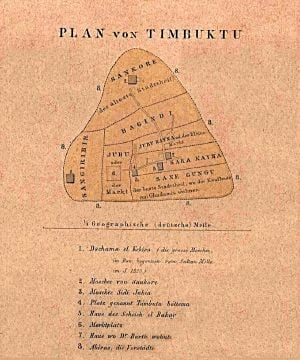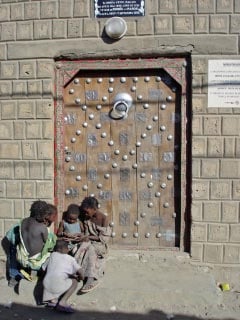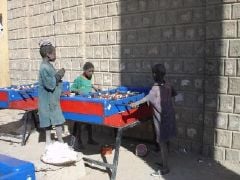Difference between revisions of "Timbuktu" - New World Encyclopedia
Mary Anglin (talk | contribs) (import, credit and claim for Brooke Winger) |
(→Further reading: formated) |
||
| Line 125: | Line 125: | ||
* [[Timbuktu Manuscripts Project]] | * [[Timbuktu Manuscripts Project]] | ||
| − | ==Further reading== | + | == Sources and Further reading == |
| − | * | + | * Braudel, Fernand. 1984. ''The perspective of the world''. New York: Harper & Row. ISBN 0060153172 and ISBN 9780060153175 |
| + | * Auster, Paul. 1999. ''Timbuktu: a novel''. New York: Henry Holt. ISBN 0805054073 and ISBN 9780805054071 | ||
| + | * Smith, David N. 1983. ''Timbuktu''. New York: Dodd, Mead. ISBN 0396082327 and ISBN 9780396082323 | ||
| + | * Jenkins, Mark. 1997. To Timbuktu. New York: W. Morrow. ISBN 0688115853 and ISBN 9780688115852 | ||
==External links== | ==External links== | ||
| − | *[http://www.wsu.edu:8080/~wldciv/world_civ_reader/world_civ_reader_2/leo_africanus.html Leo Africanus | + | * [http://www.wsu.edu:8080/~wldciv/world_civ_reader/world_civ_reader_2/leo_africanus.html Leo Africanus: Description of Timbuktu]. ''Washington State University''. Retrieved June 21, 2007. |
| − | *[http://www.manntaylor.com/shabeni.html Shabeni's Description of Timbuktu] | + | * [http://www.manntaylor.com/shabeni.html Shabeni's Description of Timbuktu]. ''The 153 Club''. Retrieved June 21, 2007. |
| − | + | * [http://edsitement.neh.gov/view_lesson_plan.asp?id=508 Trekking to Timbuktu—Student Version]. ''National Endowment for the Humanities''. Retrieved June 21, 2007. | |
| − | *[http://edsitement.neh.gov/view_lesson_plan.asp?id=508 | + | * [http://www.pbs.org/wonders/Episodes/Epi5/5_wondr6.htm Wonders: Sankore Mosque]. ''The Road to Timbuktu''. Retrieved June 21, 2007. |
| − | *[http://www.pbs.org/wonders/Episodes/Epi5/5_wondr6.htm Wonders | + | * Rashidi, Runoko. [http://www.cwo.com/~lucumi/timbuktu.html The Great University of Sankore at Timbuktu a Brief Note]. ''The Global African Presence''. Retrieved June 21, 2007. |
| − | *[http://www.cwo.com/~lucumi/timbuktu.html The University of Sankore at Timbuktu] | + | * [http://www.sum.uio.no/research/mali/timbuktu/libraries.html The Timbuktu Libraries]. ''Libraries of Timbuktu''. Retrieved June 21, 2007. |
| − | *[http://www.sum.uio.no/research/mali/timbuktu/libraries.html The Timbuktu Libraries] | + | * Pearce, Justin. October 3, 2005. [http://news.bbc.co.uk/2/hi/africa/4304922.stm Saving Mali's written treasures]. ''British Broadcasting Coorporation''. Retrieved June 21, 2007. |
| − | + | * [http://www.loc.gov/exhibits/mali/ Ancient Manuscripts from the Desert Libraries of Timbuktu]. ''Library of Congress''. Retrieved June 21, 2007. | |
| − | *[http://news.bbc.co.uk/2/hi/africa/4304922.stm Saving Mali's written treasures] | + | * Hammer, Joshua. [http://www.smithsonianmagazine.org/issues/2006/december/timbuktu.php The Treasures of Timbuktu]. ''Smithsonian''. Retrieved June 21, 2007. |
| − | *[http://www.loc.gov/exhibits/mali/ Ancient Manuscripts from the Desert Libraries of Timbuktu | ||
| − | |||
| − | *[http://www.smithsonianmagazine.org/issues/2006/december/timbuktu.php | ||
{{Geolinks-cityscale|16.7759|-3.0094}} | {{Geolinks-cityscale|16.7759|-3.0094}} | ||
| − | |||
| − | |||
| − | |||
| − | |||
| − | |||
==Notes and references== | ==Notes and references== | ||
Revision as of 00:56, 22 June 2007
| Timbuktu* | |
|---|---|
| UNESCO World Heritage Site | |
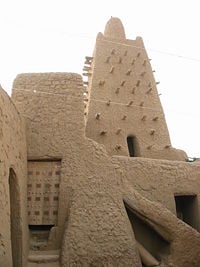
| |
| State Party | |
| Type | Cultural |
| Criteria | ii, iv, v |
| Reference | 119 |
| Region** | Africa |
| Inscription history | |
| Inscription | 1988 (12th Session) |
| Endangered | 1990-2005 |
| * Name as inscribed on World Heritage List. ** Region as classified by UNESCO. | |
Timbuktu (Archaic English: Timbuctoo; Koyra Chiini: Tumbutu; French: Tombouctou) is a city in Tombouctou Region, Mali. It is home to the prestigious Qur'anic Sankore University and other madrasas, and was an intellectual and spiritual capital and centre for the propagation of Islam throughout Africa in the 15th and 16th centuries. Its three great mosques, Djingareyber, Sankore and Sidi Yahya, recall Timbuktu's golden age. Although continuously restored, these monuments are today under threat from desertification.[1]
Timbuktu is populated by Songhay, Tuareg, Fulani, and Mandé people, and is about 15 km north of the River Niger. It is also at the intersection of an east–west and a north–south Trans-Saharan trade across the Sahara to Araouane. It was important historically (and still is today) as an entrepot for rock-salt from Taoudenni.
Its geographical setting made it a natural meeting point for nearby African populations and nomadic Berber and Arab peoples from the north. Its long history as a trading outpost that linked west Africa with Berber, Arab, and Jewish traders throughout north Africa, and thereby indirectly with traders from Europe, has given it a fabled status, and in the West it was for long a metaphor for exotic, distant lands: "from here to Timbuktu."
Timbuktu's long-lasting contribution to Islamic and world civilization is scholarship.[2] By the fourteenth century, important books were written and copied in Timbuktu, establishing the city as the centre of a significant written tradition in Africa.[3]
Origins
| Part of the series on History of Islam |
| Beliefs and practices |
|
Oneness of God |
| Major figures |
|
Muhammad |
| Texts & law |
|
Qur'an · Hadith · Sharia |
| Branches of Islam |
| Sociopolitical aspects |
|
Art · Architecture |
| See also |
|
Vocabulary of Islam |
Timbuktu was established by the nomadic Tuareg perhaps as early as the 10th century. According to a popular etymology its name is made up of: tin which means « place » and buktu, the name of an old Malian woman known for her honesty and who once upon a time lived in the region. Tuareg and other travelers would entrust this woman with any belongings for which they had no use on their return trip to the north. Thus, when a Tuareg, upon returning to his home, was asked where he had left his belongings, he would answer: «I left them at Tin Buktu », meaning the place where dame Buktu lived. The two terms ended up fusing into one word, thus giving the city the name of Tinbuktu which later became Timbuktu. However, the French orientalist René Basset forwarded a more plausible translation: in the Berber languages "buqt" means ""far away", so "Tin-Buqt(u)" means a place almost at the other end of the world, resp. the Sahara. [1]
Like its predecessor, Tiraqqa, a neighboring trading city of the Wangara, Timbuktu grew to great wealth because of its key role in trans-Saharan trade in gold, ivory, slaves, salt and other goods by the Tuareg, Mandé and Fulani merchants, transferring goods from caravans coming from the Islamic north to boats on the Niger. Thus if the Sahara functioned as a sea, Timbuktu was a major port. It became a key city in several successive empires: the Ghana Empire, the Mali Empire from 1324, and the Songhai Empire from 1468, the second occupations beginning when the empires overthrew Tuareg leaders who had regained control. It reached its peak in the early 16th century, but its capture in 1591 by a band of Moroccan adventurers was not the start so much as a symptom of the crumbling of the ancient economy with Portuguese goods that came instead from the river's mouth (Braudel pp 434–35).
The leaders of the Songhai kingdom (also spelled Songhay) began expanding their domain along the Niger River. Like the kingdoms of Ghana and Mali that flourished in the region in earlier centuries, Songhai grew powerful because of its control of local trade routes. Timbuktu would soon become the heart of the mighty Songhai Empire. It became wealthy because many merchants traveled trade routes that went through it.
Legendary tales
Tales of Timbuktu's fabulous wealth helped prompt European exploration of the west coast of Africa. Among the earliest descriptions of Timbuktu are those of Leo Africanus, Ibn Battuta and Shabeni.
The place name is said to come from a Tuareg woman named Buktu who dug a well in the area where the city stands today; hence "Timbuktu", which means "Buktu's well".
Leo Africanus
Perhaps most famous among the tales written about Timbuktu is that by Leo Africanus. As a captured renegade who later converted back to Islam from Christianity, following a trip in 1512, when the Songhai empire was at its height he wrote the following:
The rich king of Tombuto hath many plates and sceptres of gold, some whereof weigh 1300 pounds. ... He hath always 3000 horsemen ... (and) a great store of doctors, judges, priests, and other learned men, that are bountifully maintained at the king's expense. [4]
At the time of Leo Africanus' visit, grass was abundant, providing plentiful milk and butter in the local cuisine, though there were neither gardens nor orchards surrounding the city.
Shabeni
Shabeni was a merchant from Tetuan who was captured and ended up in England where he told his story of how as a child of 14, around 1787, he had gone with his father to Timbuktu. A version of his story is related by James Grey Jackson in his book An Account of Timbuctoo and Hausa, 1820:
On the east side of the city of Timbuctoo, there is a large forest, in which are a great many elephants. The timber here is very large. The trees on the outside of the forest are remarkable...they are of such a size that the largest cannot be girded by two men. They bear a kind of berry about the size of a walnut, in clusters consisting of from ten to twenty berries. Shabeeny cannot say what is the extent of this forest, but it is very large.
Center of learning
During the early 15th century, a number of Islamic institutions were erected. The most famous of these is the Sankore mosque, also known as the University of Sankore.
While Islam was practiced in the cities, the local rural majority were non-Muslim traditionalists. Often the leaders were nominal Muslims in the interest of economic advancement while the masses were traditionalists.
University of Sankore
Sankore, as it stands now, was built in 1581 C.E. (= 989 A. H.) on a much older site (probably from the 13th or 14th century)and became the center of the Islamic scholarly community in Timbuktu. The "University of Sankore" was a madrassah, very different in organization from the universities of medieval Europe. It was composed of several entirely independent schools or colleges, each run by a single master or imam. Students associated themselves with a single teacher, and courses took place in the open courtyards of mosque complexes or private residences. The primary focus of these schools was the teaching of the Qur'an, although broader instruction in fields such as logic, astronomy, and history also took place. Scholars wrote their own books as part of a socioeconomic model based on scholarship. The profit made by buying and selling of books was only second to the gold-salt trade. Among the most formidable scholars, professors and lecturers was Ahmed Baba – a highly distinguished historian frequently quoted in the Tarikh-es-Sudan and other works.
The Library of Timbuktu
The collection of ancient manuscripts at the University of Sankore and other sites around Timbuktu document the magnificence of the institution, as well as the city itself, while enabling scholars to reconstruct the past in fairly intimate detail. Dating from the 16th to the 18th centuries, these manuscripts cover every aspect of human endeavor and are indicative of the high level of civilization attained by West Africans at the time. In testament to the glory of Timbuktu, for example, a West African Islamic proverb states that "Salt comes from the north, gold from the south, but the word of God and the treasures of wisdom come from Timbuktu."
Among the libraries which have been preserving these manuscripts are: Institut des Hautes Etudes et de Recherche Islamique — Ahmed Baba, Timbuktu; Mamma Haidara Library; Fondo Kati Library; Al-Wangari Library; and Mohamed Tahar Library. These libraries are considered part of the "African Ink Road" that stretched from West Africa connecting North Africa and East Africa. At one time there were 120 libraries with manuscripts in Timbuktu and surrounding areas. There are more than one million objects preserved in Mali with an additional 20 million in other parts of Africa, the largest concentration of which is in Sokoto, Nigeria, although the full extent of the manuscripts is unknown. During the colonial era efforts were made to conceal the documents after a number of entire libraries were taken to Paris, London and other parts of Europe. Some manuscripts were buried underground, while others were hidden in the desert or in caves. Many are still hidden today. The United States Library of Congress microfilmed a sampling of the manuscripts during an exhibition there in June 2003.
Ravage and decline
The city began to decline after explorers and slavers from Portugal and then other European countries landed in West Africa, providing an alternative to the slave market of Timbuktu and the trade route through the world's largest desert. The decline was hastened when it was invaded by Morisco mercenaries armed with European-style guns in the service of the Moroccan sultan in 1591.
In 1824, the Paris-based Société de Géographie offered a 10,000 franc prize to the first non-Muslim to reach the town and return with information about it. The Scot Gordon Laing arrived in September 1826 but was killed shortly after by local Muslims who were fearful of European discovery and intervention. The Frenchman René Caillié arrived in 1828 traveling alone disguised as Muslim; he was able to safely return and claim the prize.
Robert Adams, an African-American sailor, claimed to have visited the city in 1811 as a slave after his ship wrecked off the African coast.[5] He later gave an account to the British counsel in Tangier, Morocco in 1813. He published his account in an 1816 book, The Narrative of Robert Adams, a Barbary Captive (still in print as of 2006), but doubts remain about his account. Only three other Europeans reached the city before 1890: Heinrich Barth in 1853 and the German Oskar Lenz with the Spanish Cristobal Benítez in 1880.
In the 1990s, Timbuktu came under attack from Tuareg people hoping to build their own state. The Tuareg Rebellion was symbolically ended with a burning of weapons in the town in 1996.
Timbuktu today
Today, Timbuktu is an impoverished town, although its reputation makes it a tourist attraction to the point where it even has an international airport. It is one of the eight regions of Mali, and is home to the region's local governor. It is the sister city to Djenné, also in Mali. The 1998 census listed its population at 31,973, up from 31,962 in the census of 1987.
Timbuktu is a UNESCO World Heritage Site, listed since 1988. In 1990, it was added to the list of world heritage sites in danger due to the threat of desert sands. A program was set up to preserve the site and, in 2005; it was taken off the list of endangered sites. Timbuktu is currently (beginning 2007) a candidate in a competition to choose the New Seven Wonders of the World.[6]
Timbuktu was one of the major stops during Henry Louis Gates' PBS special "Wonders of the African World". Gates visited with Abdel Kadir Haidara, curator of the Mamma Haidara Library together with Ali Ould Sidi from the Cultural Mission of Mali. It is thanks to Gates that an Andrew Mellon Foundation grant was obtained to finance the construction of the library's facilities, later inspiring the work of the Timbuktu Manuscripts Project. Unfortunately, no practising book artists exist in Timbuktu although cultural memory of book artisans is still alive, catering to the tourist trade. The town is home to an institute dedicated to preserving historic documents from the region, in addition to two small museums (one of them the house in which the great German explorer Heinrich Barth spent six months in 1853-54), and the symbolic Flame of Peace monument commemorating the reconciliation between the Tuareg and the government of Mali.
The image of the city as mysterious or mythical has survived to the present day in other countries: a poll among young Britons in 2006 found 34% did not believe the town existed, while the other 66% considered it "a mythical place".[7]
Attractions
Timbuktu's vernacular architecture is marked by mud mosques, which are said to have inspired Antoni Gaudí. These include
- Djinguereber Mosque, built in 1327 by El Saheli
- Sankore Mosque, also known as Sankore University, built in the early fifteenth century
- Sidi Yahya mosque, built in the 1441 by Mohamed Naddah.
- From 2008, NUON will set up their EDM headquarters in Timbuktu, to be headed by André Koelewijn. [citation needed]
Other attractions include a museum, terraced gardens and a water tower.
- Sahara Desert Tribal Camp.jpg
Sahara Desert Tribal Camp
Language
The main language of Timbuktu is a Songhay variety termed Koyra Chiini, spoken by over 80% of residents. Smaller groups, numbering 10% each before many were expelled during the Tuareg/Arab rebellion of 1990-1994, speak Hassaniya Arabic and Tamashek.
Famous people connected with Timbuktu
- Ali Farka Toure (1939–2006) Born in Timbuktu.[8]
- Heinrich Barth (1821-1865) German traveller and scholar and the first European to investigate into African history
- Bernard Peter de Neumann, GM (1917–1972) "The Man From Timbuctoo".[9] Held prisoner of war there along with other members of the crew of the Criton during 1941-1942.
Sister cities
 - Chemnitz, Germany
- Chemnitz, Germany - Y Gelli Gandryll (Hay-on-Wye), Wales
- Y Gelli Gandryll (Hay-on-Wye), Wales - Kairouan, Tunisia
- Kairouan, Tunisia - Marrakech, Morocco
- Marrakech, Morocco- Liopolis
 - Saintes, France
- Saintes, France -
-  - Tempe, Arizona, United States[10]
- Tempe, Arizona, United States[10]
See also
- Timbuktu Manuscripts Project
Sources and Further reading
- Braudel, Fernand. 1984. The perspective of the world. New York: Harper & Row. ISBN 0060153172 and ISBN 9780060153175
- Auster, Paul. 1999. Timbuktu: a novel. New York: Henry Holt. ISBN 0805054073 and ISBN 9780805054071
- Smith, David N. 1983. Timbuktu. New York: Dodd, Mead. ISBN 0396082327 and ISBN 9780396082323
- Jenkins, Mark. 1997. To Timbuktu. New York: W. Morrow. ISBN 0688115853 and ISBN 9780688115852
External links
- Leo Africanus: Description of Timbuktu. Washington State University. Retrieved June 21, 2007.
- Shabeni's Description of Timbuktu. The 153 Club. Retrieved June 21, 2007.
- Trekking to Timbuktu—Student Version. National Endowment for the Humanities. Retrieved June 21, 2007.
- Wonders: Sankore Mosque. The Road to Timbuktu. Retrieved June 21, 2007.
- Rashidi, Runoko. The Great University of Sankore at Timbuktu a Brief Note. The Global African Presence. Retrieved June 21, 2007.
- The Timbuktu Libraries. Libraries of Timbuktu. Retrieved June 21, 2007.
- Pearce, Justin. October 3, 2005. Saving Mali's written treasures. British Broadcasting Coorporation. Retrieved June 21, 2007.
- Ancient Manuscripts from the Desert Libraries of Timbuktu. Library of Congress. Retrieved June 21, 2007.
- Hammer, Joshua. The Treasures of Timbuktu. Smithsonian. Retrieved June 21, 2007.
-
- Mapping from Multimap or GlobalGuide or Google Maps
- Satellite image from WikiMapia
- Mapping from OpenStreetMap
Notes and references
- ↑ Timbuktu — World Heritage (Unesco.org)
- ↑ http://news.yahoo.com/s/nm/20061110/sc_nm/mali_manuscripts_dc_1
- ↑ http://news.yahoo.com/s/nm/20061110/sc_nm/mali_manuscripts_dc_1
- ↑ "Ibn Battuta and his Saharan Travels" 153 Club
- ↑ Calhoun, Warren Glenn; From Here to Timbuktu, p. 273 ISBN 0-7388-4222-2
- ↑ From Machu Picchu to Timbuktu — The Search for the World's Seven New Wonders. Der Spiegel. Retrieved 2006-12-29.
- ↑ "Search on for Timbuktu's twin" BBC News, 18 October 2006. Retrieved 28 March 2007
- ↑ "African star Ali Farka Toure dies" BBC News, 7 March 2006. Retrieved 7 March 2006
- ↑ The Daily Express, 10 February 1943. Front Page: The Man From Timbuctoo
- ↑ "Search on for Timbuktu's twin" BBC News, 18 October 2006. Retrieved 28 March 2007
Credits
New World Encyclopedia writers and editors rewrote and completed the Wikipedia article in accordance with New World Encyclopedia standards. This article abides by terms of the Creative Commons CC-by-sa 3.0 License (CC-by-sa), which may be used and disseminated with proper attribution. Credit is due under the terms of this license that can reference both the New World Encyclopedia contributors and the selfless volunteer contributors of the Wikimedia Foundation. To cite this article click here for a list of acceptable citing formats.The history of earlier contributions by wikipedians is accessible to researchers here:
The history of this article since it was imported to New World Encyclopedia:
Note: Some restrictions may apply to use of individual images which are separately licensed.

